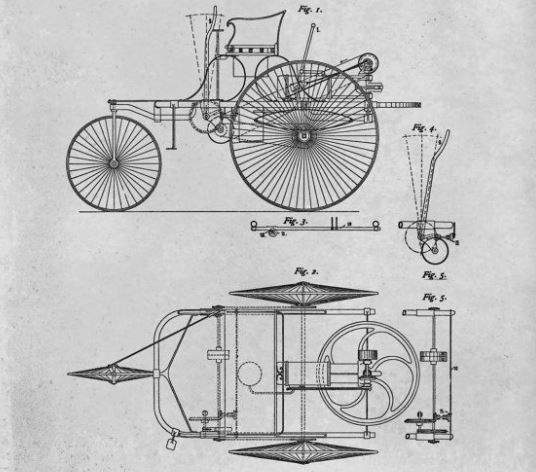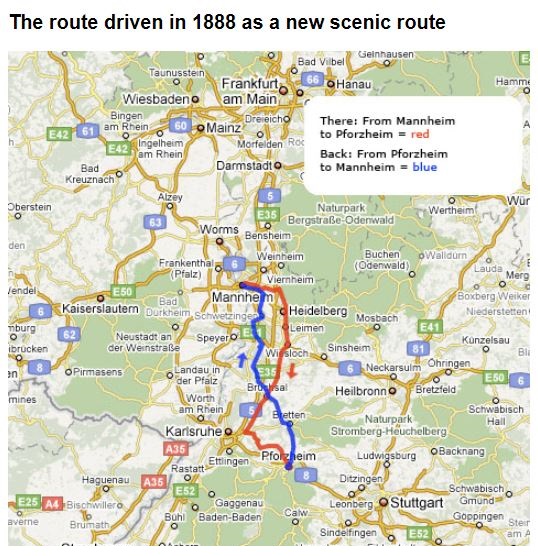Bertha Benz’s 65-mile drive in 1888 made headlines for her husband’s fledgling auto company.
German mechanical engineer Karl Friedrich Benz invented and built a three-wheel “motorwagen,” today recognized as the world’s first car. His wife helped steer the company’s first marketing campaign.
Although others had experimented with electric and steam-powered vehicles — and a gasoline-powered engine had been added to a pushcart in 1870 — mechanical engineer (and locksmith) Karl Benz invented the modern car in 1885 when he built his “Fahrzeug mit Gasmotorenbetrieb” (vehicle with gas engine) in Mannheim, Germany.

Detail from “Vehicle with Gas Engine Operation,” patent No. 37435, submitted by Karl Benz on January 29, 1884, at the Reich Patent Office in Berlin.
Born in 1844 in Baden Muehlburg, Benz founded an “Iron Foundry and Machine Shop” in 1871. He received his first engine patent eight years later.
Auto-Mobiles
On January 29, 1886, Benz applied for an Imperial patent for his three-wheeled carriage powered by a one-cylinder, four-stroke gasoline engine. Reich Patent No. 37435 has been referred to as the birth certificate of the automobile. His design was the world’s first for a practical internal combustion engine-powered automobile.
Although there had already been “auto-mobiles,” Benz used the internal combustion engine as the drive system for a “self-mover,” according to a Mercedes Benz company historian. “He presented his stroke of genius at the Imperial Patent Office – the car was born.”
Because he would quickly build several identical three-wheeled vehicles, Benz has also been credited with the first “production car” in history.

Bertha Benz in August 1888 became the first person to drive her husband’s “motorwagen” over a long distance; her publicity stunt brought wide attention…and sales.
The 1886 Benz engine – with a displacement of 0.954 of a liter – anticipated design elements still found in modern internal combustion engines, including a crankshaft with balance weights, electric ignition, and water cooling (generating 0.55 kW and a top speed of 16 km/h, virtually corresponding to the power of one horse).
It would not be long before his wife — the daughter of a wealthy German family who earlier used her dowry to help Benz — made headlines driving his new automobile.
Bertha’s Publicity Stunt
Thirty-nine-year-old Bertha Benz made history on August 12, 1888, when she became the first person to complete a long-distance trip by automobile. She followed wagon tracks on a trip that popularized Karl Benz’s latest invention and reportedly saved him from financial ruin.
Bertha drove away with the “Model III Patent Motorwagen” without her husband’s permission, although she left a note saying she was taking their 13 and 15-year-old sons to visit her mother in Pforzheim. Her route from their home in Mannheim was about 65 miles, one-way.
The soon widely publicized drive, which included stops at apothecary shops to buy a petroleum solvent needed to keep the car running, took about 15 hours. She returned home three days later.
“The value of the journey to the fledgling car company that would in time become Mercedes-Benz is hard to quantify properly, but she surely helped to ensure that by the end of the century it was the largest car company in the world,” concluded a 2013 article in The Telegraph.
“Bertha’s journey proved many things, not least that a woman was every bit as capable of handling one of these newfangled contraptions as a man,” the article also noted. “Today you can go to Mannheim and retrace her steps by following the signs of the Bertha Benz Memorial Route.”

Karl Benz’s wife Bertha was the first person to drive his gas-powered motorwagen over a long distance, bringing worldwide attention. Map courtesy Bertha Benz Memorial Route.
Meanwhile, another inventor attracted the attention of Bertha’s husband. According to Mary Bellis in her “History of Cars,” Benz retired from Benz & Company when his engine designs became outdated by those of Gottlieb Daimler.
Daimler-Benz
Daimler and his design partner Wilhelm Maybach had taken the internal combustion engine “a step further and patented what is generally recognized as the prototype of the modern gas engine,” noted Bellis. Deutsche Bank in 1926 facilitated the merger of Daimler Motorengesellschaft and Benz & Company to form Daimler-Benz AG.
Although retired, Karl Benz served as a member of the supervisory board of Daimler-Benz AG from 1926 until his death in 1929. In recognition of her historic role, Bertha Benz was inducted into the Automotive Hall of Fame as the first female automotive pioneer in 2016.
In America, Charles Duryea claimed the first U.S. patent for a gasoline automobile in 1895. One year later, Henry Ford sold his first “quadri-cycle,” creating the auto industry. By the turn of the century, about 8,000 vehicles shared mostly unpaved roads with horses and wagons.
The first U.S. auto show took place in November 1900 in New York City, where public workers annually removed 450,000 tons of horse manure from the streets. America’s highways and travel history are on exhibit at the National Museum of American History’s America on the Move.
_______________________
Recommended Reading: Bertha Takes a Drive: How the Benz Automobile Changed the World (2017); A History of the New York International Auto Show (2000). Your Amazon purchase benefits the American Oil & Gas Historical Society. As an Amazon Associate, AOGHS earns a commission from qualifying purchases.
_______________________
The American Oil & Gas Historical Society (AOGHS) preserves U.S. petroleum history. Join today as an AOGHS annual supporting member. Help maintain this energy education website and expand historical research. For more information, contact bawells@aoghs.org. Copyright © 2025 Bruce A. Wells. All rights reserved.
Citation Information – Article Title: “First Car, First Road Trip.” Authors: B.A. Wells and K.L. Wells. Website Name: American Oil & Gas Historical Society. URL: https://aoghs.org/transportation/benz-patents-first-car. Last Updated: August 7, 2025. Original Published Date: September 15, 2015.



